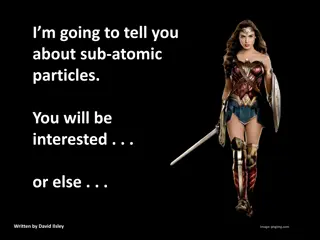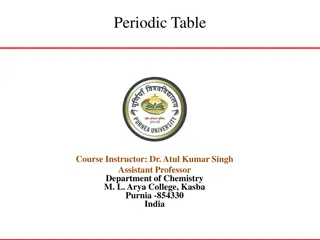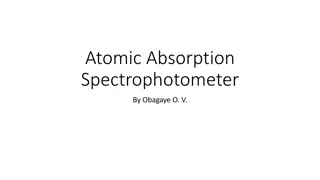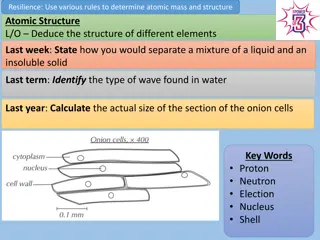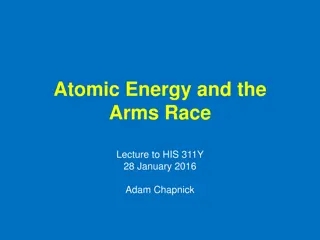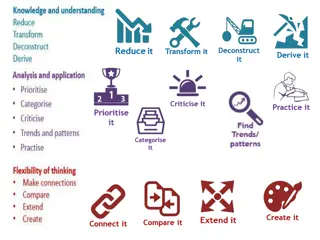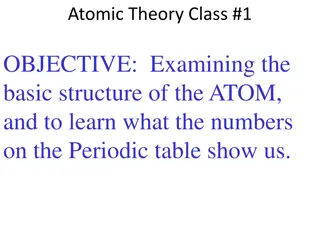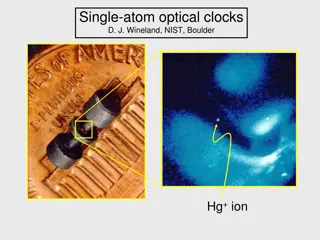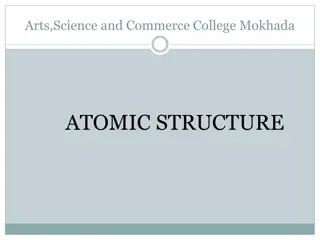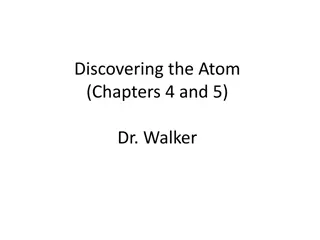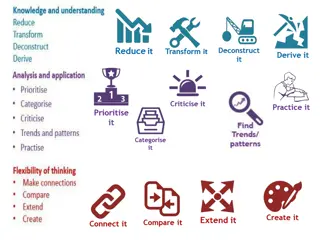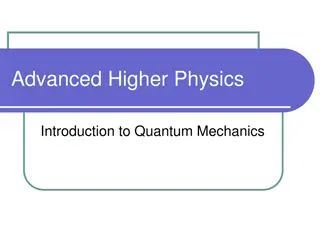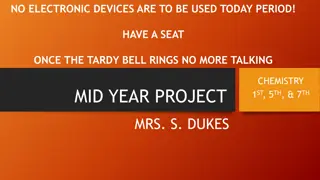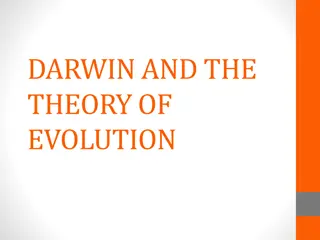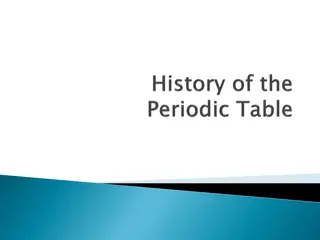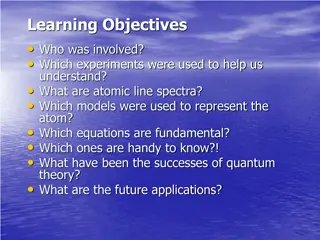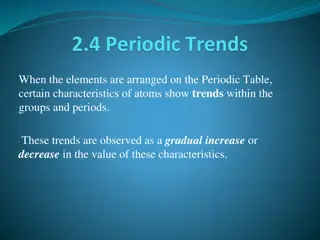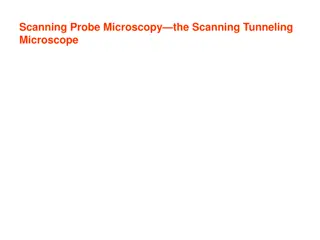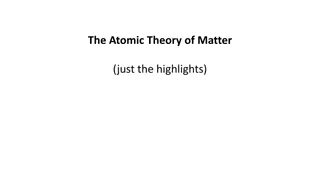Understanding Atomic Configurations and Term Symbols
The energy of atomic configurations is determined by electrostatic attraction between electrons and the nucleus, electron-electron repulsion, spin-orbit coupling, and spin-spin interactions. Term symbols in electronic spectroscopy specify atomic states using quantum numbers. Hund's rule and the Paul
8 views • 12 slides
Understanding Hyperfine Interactions in Atomic Physics
Hyperfine interactions play a crucial role in atomic physics, leading to small energy shifts and splitting of degenerate levels in atoms and molecules. These interactions involve the electromagnetic multipole interactions between the nucleus and electron clouds, resulting in the splitting of energy
13 views • 154 slides
Understanding Atomic Structure: The Evolution of Atomic Theories
Explore the journey of atomic theory from Democritus to Dalton and Thomson, uncovering the discoveries and concepts that shaped our understanding of the building blocks of matter. From the indivisible atoms proposed by Democritus to Dalton's theory of elements and compounds, and Thomson's experiment
6 views • 36 slides
The Evolution of Sub-Atomic Particle Theory
Human pursuit of understanding the universe led to the concept of atoms by Democritus and further advancements in sub-atomic particle theory. From the initial idea of indivisible atoms, to the discovery of protons, neutrons, and electrons, to modern experiments with particle accelerators, the journe
2 views • 24 slides
Unveiling the Journey of Atomic Structure Evolution
Delve into the historical perspectives and key theories that shaped our understanding of atomic structure. From Democritus' concept of indivisible atoms to Dalton's atomic theory and Thomson's discoveries on electric charges, this journey explores the evolution of atomic theory through the insights
0 views • 35 slides
Evolution of Mathematical Theories and Proof Systems
Development of mathematical theories such as model theory, proof theory, set theory, recursion theory, and computational complexity is discussed, starting from historical perspectives with Dedekind and Peano to Godel's theorems, recursion theory's golden age in the 1930s, and advancements in proof t
1 views • 29 slides
Understanding Atomic Properties and Covalent Radii in Chemistry
Exploring the concept of atomic properties including the sizes of atoms and ions, the three common operational radius concepts (covalent, crystal, and van der Waals), and the calculation of covalent radius for homonuclear and heteronuclear diatomic molecules. This overview delves into the significan
1 views • 10 slides
Understanding Atomic Absorption Spectrophotometry in Analytical Chemistry
Atomic absorption spectrophotometry (AAS) is a spectro-analytical technique used for quantitative determination of chemical elements through the absorption of light by free atoms. This method is vital in various fields like biophysics, toxicology, and archaeology, allowing the analysis of over 70 di
0 views • 9 slides
Understanding Atomic Structure and Subatomic Particles
Delve into the world of atomic structure and subatomic particles to reveal the inner workings of elements. Discover how to determine atomic mass, identify protons, neutrons, and electrons, and interpret the periodic table. Explore the key concepts of isotopes, electron configurations, and the charac
0 views • 6 slides
Understanding Atomic Structure: Electrons, Energy Levels, and Historical Models
The atomic model describes how electrons occupy energy levels or shells in an atom. These energy levels have specific capacities for electrons. The electronic structure of an atom is represented by numbers indicating electron distribution. Over time, scientists have developed atomic models based on
0 views • 5 slides
Understanding Quantum Mechanics in Atomic Structure
Exploring the connection between quantum mechanics and the fundamental elements of the periodic table, this material delves into the Schrödinger equation, quantization of angular momentum and electron spin, and the implications on atomic structure. The content covers writing the Schrödinger equati
1 views • 32 slides
Evolution of Light Theory: From Wave Theory to Quantum Theory
At the turn of the century, the discovery of the photoelectric effect challenged the wave theory of light, leading to the development of the quantum theory by Max Planck and Albert Einstein. This new theory introduced the concept of discrete energy units known as quanta, bridging the gap between wav
1 views • 62 slides
Understanding Periodic Trends: Atomic Radius and Ionization Energy
The Periodic Table displays a systematic organization of elements based on their increasing atomic number, leading to periodic patterns in their physical and chemical properties. Key trends like Atomic Radius and Ionization Energy provide insights into the size of atoms and the energy required to re
1 views • 13 slides
Understanding Atomic Structure, Elements, Mixtures, and Compounds
Exploring the basics of atomic structure, including elements, mixtures, and compounds. Learn about single atoms, molecules of elements, and compounds formed by different elements. Understand the relationship between protons, neutrons, electrons, atomic number, and atomic mass. Test your knowledge on
0 views • 6 slides
Understanding Atomic Structure and Interatomic Bonding
Atomic structure is defined by the atomic number (Z) and atomic mass (A). Quantum mechanics governs atomic and subatomic particles, introducing discrete energy levels. The Bohr atomic model describes electrons orbiting the nucleus in defined orbitals. Quantum numbers characterize electron properties
0 views • 15 slides
Insights into Canada's Atomic Energy and the Arms Race
Delve into the historical landscape of atomic energy in Canada, tracing its evolution from the early years to the political dynamics surrounding nuclear weapons during the Cold War. Explore key events such as the UN Atomic Energy Commission, Canada's industrial developments in the 1950s, and the int
0 views • 16 slides
Introduction to Atomic Masses and Mass Spectrometry
Understanding atomic masses, isotopes, and mass spectrometry in the context of chemistry, particularly the concept of standard atomic mass unit (amu) and its application in measuring the masses of atoms. The content delves into the composition of atoms, isotopes, and how to determine the mass of an
1 views • 20 slides
Exploring Physics Beyond the Standard Model through Atomic Spectroscopy
Unlocking the mysteries of physics beyond the Standard Model using atomic spectroscopy techniques. Delving into the shortcomings of the Standard Model and the quest for new physics through precision measurements of atomic forces and isotope shifts in heavy atoms. Highlighting the importance of the p
0 views • 47 slides
Exploring the Fundamentals of Atomic Structure and Matter
Delve into the intricate world of atomic structure and matter through a comprehensive study covering topics such as subatomic particles, atomic models, and key concepts like atomic number and mass. Explore the fascinating properties of atoms, their components, and their interactions, gaining insight
2 views • 15 slides
Understanding the Basic Structure of Atoms: Atomic Theory Class #1
Exploring the fundamental components of atoms, including protons, neutrons, and electrons, their charges, symbols, masses, and locations within the atom. We delve into the concept of atomic mass units (AMU) and the structure of the nucleus, as well as the behavior of electrons in relation to the nuc
0 views • 108 slides
Chemistry Review Exercise: Periodic Table and Atomic Properties Review
This detailed content covers a review exercise on the Periodic Table and Atomic Properties of various elements. It includes information on atomic structures, fundamental physical constants, and common elements found in the Periodic Table. The content explores elements from Hydrogen to Osmium, detail
0 views • 16 slides
Understanding Atomic Mass and Isotopes in Atoms
Explore the concept of atomic mass in atoms, learn to compute atomic mass and mass number, identify isotopes, and calculate the number of neutrons in an atom. Understand the significance of the atomic number and mass number in determining the characteristics of elements.
0 views • 14 slides
Understanding Atomic Structure in Introductory Chemistry
Explore the basics of atomic structure in Introductory Chemistry, covering topics such as representing elements with atomic symbols, isotopes, and atomic bookkeeping. Learn through visual aids and examples to enhance your understanding of elements, isotopes, and atomic properties.
0 views • 21 slides
Theories of Interest in Microeconomics II
Explore various theories of interest in economics, including the Classical Theory, Liquidity Preference Theory by Keynes, Productivity Theory, Abstinence Theory, Time-Preference Theory, Fisher's Time Preference Theory, and the Loanable Fund Theory. These theories offer different perspectives on the
0 views • 6 slides
The Importance of Atomic Clocks in Modern Technology
Explore the significance of precise timekeeping provided by atomic clocks, the fundamentals of atomic clocks, the advancements in single-atom optical clocks by experts like D. J. Wineland from NIST Boulder, the role of atomic energy state superpositions, and the practical operation of atomic clocks.
0 views • 33 slides
Understanding Atomic Structure: The Journey from Ancient Philosophers to Modern Theories
Exploring the evolution of atomic theory from ancient times to John Dalton's contributions, the concept of indivisible atoms forming elements, atomic spectra of hydrogen, and Bohr's atomic model. Delve into the limitations of Bohr's model and the complexities of multi-electron atoms.
0 views • 15 slides
Evolution of Atomic Theory: From Democritus to Thomson
Examine the evolution of atomic theory through the contributions of key scientists such as Democritus, Dalton, and Thomson. Explore the concept of subatomic particles, different models of the atom, and the impact of experiments on our understanding of the atom over time. From the solid sphere model
0 views • 33 slides
Understanding Scientific Modelling in Atomic Theory
Explore the use of scientific modelling in atomic theory through a learning journey covering topics like the atom, hazards, risks, and atomic structure. Engage in a True or False task to test your knowledge and delve into a video timeline on the discovery of silver and gold elements.
0 views • 11 slides
Evolution of Atomic Models: From Ancient Philosophers to Quantum Mechanics
Tracing the evolution of atomic models from the ancient Greek philosophers' concept of indivisible atoms to the groundbreaking discoveries of electrons, protons, and neutrons. The journey through Thomson's Plum Pudding model, Rutherford's planetary model, Bohr's quantized model, and the introduction
0 views • 14 slides
Understanding Atomic Structure and Laws of Matter
Explore the fundamental concepts of atomic structure, including the size of atoms, evidence of atomic composition, and key laws of matter such as the Law of Conservation of Mass. Delve into the historical understanding of atomic structure and the contributions of significant scientists like John Dal
0 views • 29 slides
Exploring the Evolution of Atomic Theory
Delve into the historical journey of atomic theory starting from Democritus and Aristotle's views to modern advancements proving some aspects of Dalton's theory incorrect. Learn about key laws and theories such as the Particle Theory of Matter, Dalton's Atomic Theory, and JJ Thomson's discoveries, s
0 views • 30 slides
Evolution of Atomic Theory Through the Ages
Explore the fascinating journey of the atomic theory from the ancient ideas of Democritus in 450 BC to the groundbreaking discoveries by scientists like Benjamin Franklin, John Dalton, Sir William Crookes, J.J. Thomson, and more. Witness the evolution of our understanding of atoms and their structur
0 views • 21 slides
Evolution of Atomic Theory: From Democritus to JJ Thomson
Foundations of atomic theory trace back to Democritus and Aristotle, evolving through the discovery of laws in the 18th century by Dalton's Atomic Theory. Modern advancements and JJ Thomson's discoveries led to a deeper understanding of the structure of atoms.
0 views • 40 slides
Explore the History of Atomic Theory: Mid-Year Project Guidelines
Dive into the history of the atom and its significance in the scientific world through a group project that encompasses research on prominent scientists and their contributions to atomic theory. Follow guidelines for presentation and submission while delving into the fascinating journey of atomic di
0 views • 14 slides
Darwin and the Theory of Evolution: A Comprehensive Overview
Darwin's Theory of Evolution encompasses the concepts of organisms changing over time and life evolving through natural selection. Influenced by scientists such as James Hutton, Jean Baptiste Lamarck, and Alfred Russel Wallace, Darwin's theory culminates in the idea of evolution by natural selection
0 views • 9 slides
Evolution of the Periodic Table: From Russian Chemist's Observations to Modern Classification
Russian chemist initially observed common properties in elements and arranged them by atomic mass, leading to the discovery of periodicity. English scientist later refined the arrangement by atomic number. The modern periodic table categorizes elements into groups with similar properties, based on a
0 views • 36 slides
Quantum Theory and Key Figures in Physics
Explore the evolution of quantum theory through the perspectives of renowned physicists such as Albert Einstein, Niels Bohr, Werner Heisenberg, Erwin Schrödinger, Prince Louis de Broglie, and Max Planck. Learn about atomic line spectra, fundamental equations, and models used to represent the atom.
0 views • 23 slides
Understanding Periodic Trends in Atomic Characteristics
Periodic trends in atomic characteristics such as atomic radius, ionization energy, ion size, and electronegativity are essential in understanding the behavior of elements. These trends are influenced by factors like the energy levels and the number of protons and electrons in an atom. The atomic ra
0 views • 23 slides
Exploring Atomic Dimensions: Scanning Probe Microscopy
Delve into the world of nanoscale imaging with Scanning Probe Microscopy (SPM) techniques like Scanning Tunneling Microscopy (STM) and Atomic Force Microscope (AFM). Unlike optical microscopes, SPM methods break the diffraction limit by relying on intermolecular forces and quantum tunneling for unpa
0 views • 26 slides
Unveiling the Atomic Theory of Matter: Highlights
Matter comprises atoms and molecules in continuous motion, as evidenced by Brownian motion. The precise size of atoms was estimated at 10^-10 meters through experiments. The arrangements of molecules differ in solids, liquids, and gases, with Feynman highlighting the significance of the atomic hypot
0 views • 33 slides



